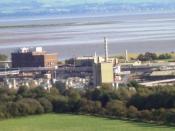It has been strongly emphasized that the fundamental goal of all business is to maximize shareholder value, as the focus of business argument now changed from giant firm in product market to giant firm facing the capital market. Especially, since the 1990's, there was a significant increasing demand from top companies for shareholder value, and shareholder value was subsequently used in Britain and USA as a management justification for the corporate restructuring and downsizing which promised to deliver increased rates of return. There are some reasons that the demands and pressures of the US and UK capital markets were more urgent to maximize shareholder value. Firstly, the US and UK markets were much larger in terms of market capitalization relative to GDP, meaning that it is no longer that productivity is a key to success. Second, in both the UK and USA, there was a clear shift in ownership from direct ownership (households) to institutions, such as pensions and insurance funds.
This is because such institutions were allowed to invest on stock market since 1980, and more people invest into pension funds to get higher and better return rather than putting money into the bank with the relatively low interests. These institutions own 60% of shares in UK and they act as an agent for people and achieved a lot of power to influence company.
In this essay, I am going to highlight the importance of shareholder value and reveal the needs for a more reliable measurement system rather than traditional measurement such as discounted cash flow. After that, moving on to the facts of strategies that can be applied into the companies in order to maximize shareholder value and analyze problems occurring on the process of practicing those strategies with some examples such as Glaxo-Wellcome, GEC and BT.
Shareholder value is the financial value created for shareholders by the companies in which they invest. With the increasing global competition, the success of a company is depends largely upon continued shareholder patronage and its success in the stock markets. Every company has to give absolute importance to shareholder value creation in order to gain a competitive edge in business. It is very logical to say that the companies that are unable to create shareholder value will find that capital flows going away from them and they will not have enough capital to run their business. Moreover, The role of fund manager of driving up the market value of shares year on year also shows the increasing importance of pursuing shareholder value. As stated in the introduction, an implication of the increasing importance of institutional ownership is that management of share portfolios is delegated to professional fund managers who are often judged on the basis of short-term performance. This not only adds pressure to perform on those companies whose shares are mainly held by institutions, it also influences the composition of share portfolio. For example, Golding (2001) argues that small and medium-size firms in terms of their capitalization are relatively unattractive to fund managers because they cannot offer the required level of liquidity.
It is therefore becoming important for companies to measure the value they create for their stakeholder, as value is the best metric of performance that is comprehensive and hence is useful for decision-making. As stated above, traditional measures are criticized for having low correlation with shareholder value creation, new valuation methods, therefore, are needed to measure the shareholder value creation. These new valuation methods are EVA (Economic Value Added), MVA (Market Value Added), CFROI (Cash Flow Return On Investment) and TSR (Total Shareholder Return). These methods are designed to establish whether a business is adding to or destroying shareholder value. Among all these Metrics, the most widely used metric, EVA, proposed and trademarked by Stern Stewart, allows us to generalize about the distribution of returns across the corporate sector in relation to the capital market's expectations (Froud, 2000). In addition, along with EVA, Return on capital employed (ROEC) is also a key measure in appraising firm performance.
In order to maximize shareholder value in mature economy industry, companies have to alter their strategies. I am going to take GEC as an example to elucidate how company increases their value without organic growth. GEC provides a mature industry example of high-velocity restructuring through corporate dealing and large-scale disemployment in the absence of organic growth. GEC became a giant firm through mergers in 1960's and contested into heavy electricals, telecoms and defence electronics, where following a trajectory with a strong growth. However, as some of the business reached a state of maturity, thus the company cannot generate shareholder value anymore, and GEC carried out major restructuring involving mainly cutting down labour costs. As labour costs have been halved since 1988, it retained its shareholder value stable.
Another example of restructuring can be taken as Glaxo. Glaxo achieved spectacular organic growth through aggressive marketing of Zantac, an anti-ulcer drug. The use long patent and intellectual property rights such as Zantac can give significant benefits to the company in terms of cost recovery. However, Glaxo faced the prospect of patent expiry on its blockbuster product and acquisition of Wellcome in 1995 was Glaxo's response (Froud 2000). This horizontal merger generally creates scope for head-count reductions, as duplicated functions and overlapping activities are pruned when two companies in the same line of business merge (Froud 2000). This reduction costs broadly translated into manufacturing, R&D and sales staff. Thus, it increased its shareholder value after merger. It is important to note that as Glaxo-Wellcome's reduction costs go into R&D and manufacturing, it could develop more on new drugs and deliver strong organic growth and financial returns, and thus The Sunday Times said "Companies such as Glaxo-Wellcome and Vodafone are all businesses that have managed to build huge volumes of sales largely without acquisitions and organic growth and expansion appear to be the best way to generate the best returns".
However, there are some complications arising after restructuring. Firstly, the costs savings created by head-count reductions that creates casualties often also generates the possibility of real wage increases for survivors. For example, BT, privatized in 1984 with over 50% of the shares privately held, has carried out a major restructuring resulting in 120,000 reduction in employment and an increase in P/S ratio due to outsourcing. The survivors from this restructuring benefited from pay rise. Even though BT was able to cut the labour costs by half, they could not increase rates of return due to wage raise and paying for outsourcing. For casualties of restructuring, their loss depends on their prospects of re-employment, which obviously vary according to the identity of the worker in terms of age, gender, skills and mobility as well as on the regional context and the macro environment (Froud 2000). While some find equivalent employment, others find employment in personal sector where their health and standard living could be damaged.
Secondly, the problem arises in relation to the capital market, which allows workers a dual identity as shareholder as well as workers. Therefore, big-company pension schemes can ease the financial loss of casualties of restructuring.
As can be seen, firms are constantly looking for new opportunities to create value added and EVA. Companies pay a lot of attention to the short-term objective and targets, like continuous increase of quarterly profits by delaying needed investment or focus on mergers and acquisitions, and considerably less attention to the long-term objectives, like investing in clean production techniques, innovation, the quality of personnel and the environment. Such a short-term focus, however, is not without danger and is a potential threat to the continuity of an organisation. The company will not be able to achieve sustainable growth and will not be innovative enough to keep its customers satisfied with new products and services. In short, a focus on the short-term bottom line prevents a company from becoming and staying a 'living' organisation. For becoming such a company, a balance in focus between short-term and long-term objectives is needed, together with attention for all stakeholders, rather than just shareholders, of the company. Glaxo is a good example of organization with stressing on long-term objectives. Even though new product development is a slow business in pharmaceuticals with a mean time of 12 years synthesis to first launch largely, Glaxo spent enormous amount of money on employing another 20,000 people in 6 years, as a result, Glaxo shows that a patent protected drug, couple with aggressive marketing can turn an industry into the 'most successful company in the world' (Economics in a business context 3rd edition).
It is also important to note that building strong relationship with all stakeholders is the key to sustain long-term growth, as they indirectly affect the rates of return. Stakeholder emphasizes responsibility over profitability and believes an organization success should be measured by the satisfaction among all stakeholders (http://www.valuebasedmanagement.net/faq_shareholder_stakeholder_perspective.html). For example, if tobacco companies ignore the voice of the smoke-free institutions and carry out offensive marketing against them, it will have bad images in public and thus their value of the company will be deteriorated. They need to pay careful attention to the trends of all the stakeholders, as they are company's possible shareholders, then it will maximize societal health.
In conclusion, as there has been a significant increasing demand for maximizing shareholder value, firms had searched ways to deliver shareholder value. In order to achieve high rates of return, firstly, firms used new measurement system such as EVA to allow us to generalize about the distribution of returns so that attract more investments. Second, merger and acquisition (M&A) offered the possibility of substituting a rapid trajectory for inorganic growth for a slow trajectory of organic growth. Some other ways of maximizing shareholder value are low P/S ratio, organic growth, expansion of business and technology and relationship with stakeholder etc. However, it is important to note that in the absence of product market, there are limitations on companies to deliver earning for shareholders. There is no doubt that company with strong growth in their product market will succeed in this global capital market.
Moreover, Macro conditions are also crucial effect in capital market. With favourable macro conditions, restructuring could become a way of speeding the reallocation of labour to other jobs which were just as good or better, with all sharing in the gains of shareholders (Froud 2000).
However, in reality, some companies do not pursue shareholder value, as there is the persistent gap between investor expectations and what management can deliver.
In short, in order to achieve high shareholder value, companies have changed strategies as stated above in conclusion and it is important for companies to give more concern on the importance of both delivering earning for shareholders and achieving long-term objectives by investing into R&D.


